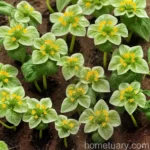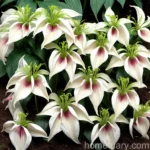The Fascinating World of American Evergreen (Syngonium podophyllum)
As a plant scientist, I am always intrigued by the diversity and beauty of plant species. One such captivating plant is the American Evergreen, scientifically known as Syngonium podophyllum. This evergreen plant has garnered attention not only for its aesthetic appeal but also for its exceptional qualities and uses. In this comprehensive guide, we will delve into the intriguing world of Syngonium podophyllum and explore every aspect of its care, characteristics, and cultivation.
What is Syngonium Podophyllum?
Syngonium podophyllum, commonly referred to as the American Evergreen, is a species of flowering plant in the family Araceae. It is native to Latin America and the Caribbean, where it thrives in the tropical rainforests. The plant is known for its distinctively shaped leaves and its ability to adapt to various indoor conditions, making it a popular choice for indoor gardens and as a decorative houseplant.
This versatile plant is also celebrated for its air-purifying properties, adding to its allure as a desirable indoor plant. It is characterized by its arrowhead-shaped leaves, which often display striking variegation, ranging from vibrant greens to deep, rich hues. With its graceful and trailing growth habit, Syngonium podophyllum can be cultivated as a hanging plant or trained to climb with the support of a stake or trellis.
Key Takeaways
To provide a comprehensive understanding of the American Evergreen (Syngonium podophyllum), let’s explore its essential aspects, including its cultural requirements, uses, and characteristics.
Culture
Cultivating Syngonium podophyllum involves understanding and replicating its natural habitat to ensure optimal growth and development. This includes considerations such as water requirements, sunlight exposure, soil composition, and more. By emulating its native environment, we can create ideal conditions for the American Evergreen to thrive in indoor settings.
Uses
Syngonium podophyllum serves a dual purpose as both an ornamental plant and an air purifier. Its lush foliage and elegant growth habit make it a popular choice for interior decoration, adding a touch of natural beauty to homes and offices. Moreover, its air-purifying capabilities contribute to creating a healthier indoor environment by filtering toxins from the air.
Water
Watering is a critical aspect of caring for Syngonium podophyllum. Proper moisture levels are essential for its growth and overall health. In general, consistently moist but well-drained soil is ideal for this plant. Overwatering should be avoided to prevent root rot, while allowing the soil to dry out too much can lead to leaf wilting and stress.
It is recommended to water the plant thoroughly and allow excess water to drain from the pot. Regularly check the moisture levels in the soil and adjust the watering frequency based on environmental conditions and the plant’s specific needs.
Sunlight
Syngonium podophyllum thrives in bright, indirect light. While it can tolerate lower light conditions, its growth may become more compact, and its variegation less pronounced. Direct sunlight should be avoided, as it can scorch the leaves and cause damage. Placing the plant near a north or east-facing window often provides the ideal lighting conditions for Syngonium podophyllum.
Fertilizer
Fertilizing Syngonium podophyllum is essential for promoting healthy growth and vibrant foliage. A balanced, water-soluble fertilizer formulated for houseplants can be applied during the growing season, typically from spring to early fall. It is important to follow the recommended dilution and application frequency provided on the fertilizer’s label to prevent over-fertilization, which can harm the plant.
Soil
The choice of soil is pivotal in ensuring the well-being of Syngonium podophyllum. A well-draining, lightweight potting mix with a high organic matter content is ideal for this plant. A mix formulated for aroids or general indoor plants can provide the necessary aeration and moisture retention. Additionally, adding perlite or orchid bark to the soil mix can enhance drainage and prevent waterlogging.
Pruning
Pruning plays a role in shaping the growth of Syngonium podophyllum and maintaining its attractive appearance. Regular removal of any yellowing or damaged leaves helps to channel the plant’s energy into new growth. Additionally, trimming back leggy stems encourages bushier growth and prevents the plant from becoming overly sparse.
Propagation
Propagating Syngonium podophyllum can be achieved through stem cuttings. To propagate the plant, select a healthy stem cutting with several nodes and aerial roots. Place the cutting in a container of water or directly in moist potting mix, ensuring that at least one node is submerged or covered. With the right conditions, the cutting will develop roots and eventually grow into a new plant.
Container Popularity
Syngonium podophyllum is widely grown in containers, making it a popular choice for indoor gardens and small spaces. Its compact growth habit and elegant trailing vines make it suitable for hanging baskets, decorative pots, or as a climbing plant with the support of a moss pole or trellis.
Container Common Diseases
Although Syngonium podophyllum is generally resilient, it can be susceptible to certain diseases and pests. Common diseases that may affect the plant include leaf spot diseases, root rot, and fungal issues. Maintaining proper cultural practices, including adequate airflow, controlled watering, and suitable lighting, can mitigate the risk of these diseases.
Disease Diagnosis
Diagnosing diseases in Syngonium podophyllum involves closely monitoring the plant for any signs of distress or abnormality. Symptoms such as leaf spots, yellowing foliage, or wilting can indicate potential issues. Identifying the specific symptoms and conducting a thorough assessment of the plant’s care regimen can help pinpoint the cause of the problem.
Common Pests
Like many indoor plants, Syngonium podophyllum may encounter pest infestations, with common pests including spider mites, aphids, and mealybugs. Regularly inspecting the foliage and stems for signs of pests and promptly addressing any infestations is crucial in maintaining the plant’s health. Using natural pest control methods or insecticidal soap can effectively manage pest populations.
Botanist’s Tips
To nurture a thriving Syngonium podophyllum, consider the following tips:
– Monitor soil moisture levels regularly to maintain appropriate hydration.
– Provide the plant with bright, indirect light to promote healthy growth and vibrant foliage.
– Use a well-draining potting mix to prevent waterlogging and promote root health.
– Adjust watering frequency based on seasonal changes and the plant’s growth patterns.
– Prune the plant regularly to remove damaged or yellowing leaves and encourage bushier growth.
Fun Facts
- Syngonium podophyllum is also known by other common names, including arrowhead plant and arrowhead vine, referring to the shape of its leaves.
- The plant’s leaves can vary widely in color and variegation, adding to its ornamental appeal.
- In addition to its aesthetic qualities, Syngonium podophyllum is valued for its air-purifying properties, enhancing indoor air quality.
Links to External Resources
To further explore the world of Syngonium podophyllum and gain valuable insights into its care and cultivation, consider the following external resources:
– American Evergreen Plant Care Tips
– Syngonium Podophyllum Varieties
– Best Soil for Syngonium Podophyllum
– Syngonium Podophyllum Propagation
– Syngonium Podophyllum Indoor Care
Conclusion
In conclusion, Syngonium podophyllum, the American Evergreen, is a captivating plant that offers a myriad of benefits, from its aesthetic appeal to its air-purifying properties. By understanding the cultural requirements, uses, and characteristics of this plant, we can create an ideal environment for it to thrive as an indoor ornamental accent. With the right care and attention, Syngonium podophyllum can grace our living spaces with its lush foliage and contribute to a healthier, more vibrant indoor atmosphere. Whether displayed in a decorative container or trained as a climbing specimen, the American Evergreen continues to captivate plant enthusiasts with its enduring charm and natural elegance.















